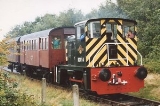
List of British Rail modern traction locomotive classes
Encyclopedia
This page lists every locomotive allocated a TOPS
classification and all modern traction (e.g. diesel
, electric
, gas turbine
, petrol
) stock used on the mainline network since 1948 (i.e. British Rail
ways and post-privatisation).
A large number of different shunter types were purchased by British Rail
and its predecessors, many of which were withdrawn prior to the introduction of TOPS
. The tables below attempt to list the different types and the different classifications used to describe them as clearly as possible:


. In order to circumvent restrictions of the application software, these ships were entered on TOPS as locomotives, 'hauling' the trains which they carried on board.
to test them.
class numbers were allocated to proposed locomotives, both diesel and electric, which for many reasons were not proceeded with.
TOPS
Total Operations Processing System, or TOPS, is a computer system for managing the locomotives and rolling stock owned by a rail system...
classification and all modern traction (e.g. diesel
Diesel locomotive
A diesel locomotive is a type of railroad locomotive in which the prime mover is a diesel engine, a reciprocating engine operating on the Diesel cycle as invented by Dr. Rudolf Diesel...
, electric
Electric locomotive
An electric locomotive is a locomotive powered by electricity from overhead lines, a third rail or an on-board energy storage device...
, gas turbine
Gas turbine locomotive
A Gas turbine locomotive is a locomotive powered by a gas turbine. The majority of gas turbine locomotives have had electric transmission but mechanical transmission has also been used, particularly in the early days. The advantage of using gas turbines is that they have very high power-to-bulk...
, petrol
Petrol engine
A petrol engine is an internal combustion engine with spark-ignition, designed to run on petrol and similar volatile fuels....
) stock used on the mainline network since 1948 (i.e. British Rail
British Rail
British Railways , which from 1965 traded as British Rail, was the operator of most of the rail transport in Great Britain between 1948 and 1997. It was formed from the nationalisation of the "Big Four" British railway companies and lasted until the gradual privatisation of British Rail, in stages...
ways and post-privatisation).
Diesel locomotives
The 1955 diesel locomotive classes are given in brackets where applicable.A large number of different shunter types were purchased by British Rail
British Rail
British Railways , which from 1965 traded as British Rail, was the operator of most of the rail transport in Great Britain between 1948 and 1997. It was formed from the nationalisation of the "Big Four" British railway companies and lasted until the gradual privatisation of British Rail, in stages...
and its predecessors, many of which were withdrawn prior to the introduction of TOPS
TOPS
Total Operations Processing System, or TOPS, is a computer system for managing the locomotives and rolling stock owned by a rail system...
. The tables below attempt to list the different types and the different classifications used to describe them as clearly as possible:
Small shunters: under 300 hp
Shunter classes are listed by 1955 class, which puts TOPS classes in ascending order, and generally puts 1948 and 1962 classes in ascending order. Unclassed shunters are placed at the start of the table; TOPS class 07 has been placed so its 1962 class is in the logical place.| Class | Numbers | Year(s) built |
Quantity built |
Year(s) withdrawn |
Image | ||||
|---|---|---|---|---|---|---|---|---|---|
| TOPS TOPS Total Operations Processing System, or TOPS, is a computer system for managing the locomotives and rolling stock owned by a rail system... |
1948 | 1955 | 1962 | 1948 | 1957 | ||||
| 11104 British Rail 11104 British Railways' 11104 locomotive was built by F. C. Hibberd & Co Ltd and introduced by British Railways in 1959. Its departmental number was 52.-External links:*... |
1950 | 1 | 1967 | ||||||
| 13000 | N/A | 1934 | 1 | 1949 | |||||
| DY1 | D1/1 British Rail Class D1/1 British Rail Class D1/1 was a class of locomotive commissioned by British Rail in England. It was a diesel locomotive in the pre-TOPS period built by the Hunslet Engine Company with a Gardner 6L3 engine.... |
1/15 | 11500–11502 | D2950–D2952 | 1954–55 | 3 | 1966–67 | ||
| Class 01 British Rail Class 01 The British Rail Class 01 diesel locomotive was a short wheelbase 0-4-0 diesel-mechanical design intended for use in areas with tight curves and limited clearance.-History:Four examples were built by Andrew Barclay Sons & Co. of Kilmarnock in 1956... |
DY2 | D1/2 British Rail Class 01 The British Rail Class 01 diesel locomotive was a short wheelbase 0-4-0 diesel-mechanical design intended for use in areas with tight curves and limited clearance.-History:Four examples were built by Andrew Barclay Sons & Co. of Kilmarnock in 1956... |
1/12 | 11503–11506, 81 | D2953–D2956, D2956 (ii) | 1956–58 | 5 | 1966–81 | |
| DY5 | D1/3 British Rail Class D1/3 British Rail Class D1/3 was a locomotive commissioned by British Rail in England. It was a diesel powered locomotive in the pre-TOPS period built by Ruston & Hornsby.-Sources:... |
1/16 | 11507–11508 | D2957–D2958 | 1956 | 2 | 1967–68 | ||
| Class 02 British Rail Class 02 The British Rail Class 02 were a class of twenty 0-4-0 diesel-hydraulic shunting locomotives built by the Yorkshire Engine Company in 1960 and 1961 for service in areas of restricted loading gauge and curvature such as docks... |
D1/4 British Rail Class 02 The British Rail Class 02 were a class of twenty 0-4-0 diesel-hydraulic shunting locomotives built by the Yorkshire Engine Company in 1960 and 1961 for service in areas of restricted loading gauge and curvature such as docks... |
1/17 | D2850–D2869 | 1960–61 | 20 | 1969–75 |  |
||
| DY11 | D2/1 British Rail Class D2/1 British Rail Class D2/1 was a locomotive commissioned by British Rail in England. It was a diesel powered locomotive in the pre-TOPS period built by the North British Locomotive Company with a Paxman engine.-Sources:... |
2/4A | 11700–11707 | D2700–D2707 | 1953–56 | 8 | 1964–68 | ||
| Class 03 British Rail Class 03 The British Rail Class 03 locomotive is, together with Class 04, one of BR's most successful smaller 0-6-0 diesel-mechanical shunters. The class, numbering 230 examples, was built by British Railways' Swindon and Doncaster works in 1957-1962 and numbered D2000-D2199 and D2370-D2399... |
DJ15 | D2/2 British Rail Class 03 The British Rail Class 03 locomotive is, together with Class 04, one of BR's most successful smaller 0-6-0 diesel-mechanical shunters. The class, numbering 230 examples, was built by British Railways' Swindon and Doncaster works in 1957-1962 and numbered D2000-D2199 and D2370-D2399... |
2/1 | 11187–11211 | D2000–D2199 D2370–D2399 |
1957–62 | 230 | 1968–93 except 03179 still in use |
 |
| Class 04 British Rail Class 04 The British Rail Class 04 0-6-0 diesel-mechanical shunting locomotive class was built between 1952 and 1962 and was the basis for the later Class 03 built in the British Railways workshops. The Class 04 locomotives were supplied by the Drewry Car Co., which at the time had no manufacturing... |
DJ12/1 | D2/4 British Rail Class 04 The British Rail Class 04 0-6-0 diesel-mechanical shunting locomotive class was built between 1952 and 1962 and was the basis for the later Class 03 built in the British Railways workshops. The Class 04 locomotives were supplied by the Drewry Car Co., which at the time had no manufacturing... |
2/13 | 11100–11115 | D2200–D2214 | 1952–62 (D2341 1948) |
142 | 1967–72 |  |
| DJ12/2 | D2/13 British Rail Class 04 The British Rail Class 04 0-6-0 diesel-mechanical shunting locomotive class was built between 1952 and 1962 and was the basis for the later Class 03 built in the British Railways workshops. The Class 04 locomotives were supplied by the Drewry Car Co., which at the time had no manufacturing... |
2/13 | 11116–11229 | D2215–D2341 | |||||
| DJ14 | D2/5 British Rail Class D2/5 British Rail Class D2/5 was a locomotive commissioned by British Rail in England. It was a diesel powered locomotive in the pre-TOPS period built by Andrew Barclay with a Gardner engine.-Sources:... |
2/12A | 11177–11186 | D2400–D2409 | 1956–57 | 10 | 1967–69 | ||
| D2/7 British Rail Class D2/7 British Rail Class D2/7 was a locomotive commissioned by British Rail in England. It was a diesel powered locomotive in the pre-TOPS period built by Hudswell Clarke with a Gardner engine... |
2/14 | 11116–20, 11144–48 | D2500–D2509 | 1955–56 | 10 | 1967 |  |
||
| Class 05 British Rail Class 05 The British Rail Class 05 is a class of 0-6-0 diesel-mechanical shunters built by Hunslet Engine Company from 1955 to 1961. They were used on the Eastern and Scottish Regions of British Railways. Initially they were numbered 11136-11176 and, later, D2550-D2619.... |
DJ13 | D2/8 British Rail Class 05 The British Rail Class 05 is a class of 0-6-0 diesel-mechanical shunters built by Hunslet Engine Company from 1955 to 1961. They were used on the Eastern and Scottish Regions of British Railways. Initially they were numbered 11136-11176 and, later, D2550-D2619.... |
2/15A | 11136–43, 11161–76 | D2550–D2573 | 1955–61 | 79 | 1966–68, 1983 | 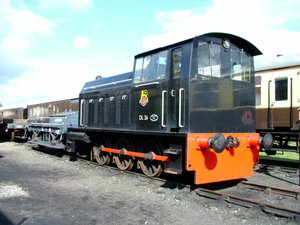 |
| DJ13/2 | D2/9 British Rail Class 05 The British Rail Class 05 is a class of 0-6-0 diesel-mechanical shunters built by Hunslet Engine Company from 1955 to 1961. They were used on the Eastern and Scottish Regions of British Railways. Initially they were numbered 11136-11176 and, later, D2550-D2619.... |
2/15 | D2574–D2618 | ||||||
| Class 06 British Rail Class 06 The British Rail Class 06 is a class of 0-4-0 diesel-mechanical shunters built by Andrew Barclay from 1958 to 1960 for use on the Scottish Region of British Railways... |
D2/6 British Rail Class 06 The British Rail Class 06 is a class of 0-4-0 diesel-mechanical shunters built by Andrew Barclay from 1958 to 1960 for use on the Scottish Region of British Railways... |
2/12 | D2410–D2444 | 1958–60 | 35 | 1967–84 |  |
||
| DY11 | D2/10 British Rail Class D2/10 British Rail Class D2/10 was a locomotive type commissioned by British Rail. It was a diesel-hydraulic shunting locomotive in the pre-TOPS period built by the North British Locomotive Company... |
2/4 | 11708–11719 | D2708–D2719 | 1957 | 12 | 1967 | ||
| 2/4B | D2720–D2780 | 1958–61 | 61 | 1967–68 | |||||
| D2/11 British Rail Class D2/11 In 1958 Brush Traction Ltd and Beyer Peacock co-operated to produce five prototype diesel-electric shunting locomotives of 0-4-0 wheel arrangement. They were intended to demonstrate a new generation of diesel shunters for industrial and mainline use. Two were loaned to British Railways for trials,... |
2/2 | D2999 | 1958 | 1 | 1967 | ||||
| D2/12 British Rail Class D2/12 British Rail Class D2/12 was a locomotive commissioned by British Rail in England. It was a diesel powered locomotive in the pre-TOPS period built by Hudswell Clarke with a Gardner engine... |
2/14A | D2510–D2519 | 1961 | 10 | 1967 | ||||
| Class 07 British Rail Class 07 The British Rail Class 07 diesel locomotive is an off-centre cab dock shunter used in Southampton Docks, to replace SR USA Class steam locomotives. It is a 0-6-0 diesel-electric shunter built by Ruston & Hornsby in 1962... |
2/16 | D2985–D2998 | 1962 | 14 | 1973–77 | _shunter_at_eastleigh.jpg) |
|||
| D3/1 British Rail Class D3/1 British Rail Class D3/1 was a locomotive commissioned by British Rail in England. It was a diesel powered locomotive in the pre-TOPS period built by the North British Locomotive Company... |
3/4 | D2900–D2913 | 1958–59 | 14 | 1967 | ||||
- Relation between TOPS, 1948, 1955 and 1962 classes, and 1948, 1957 and TOPS numbers:
Large shunters: 300–799hp
| CLASS | NUMBERS | Built | Quantity | Withdrawn | Image | ||||
|---|---|---|---|---|---|---|---|---|---|
| TOPS TOPS Total Operations Processing System, or TOPS, is a computer system for managing the locomotives and rolling stock owned by a rail system... |
1948 | 1955 | 1962 | 1948 | 1957 | ||||
| 15107 British Rail 15107 British Rail 15107 was a locomotive commissioned by the Great Western Railway, but delivered to British Railways after nationalisation. It was a diesel powered locomotive in the pre-TOPS period built by Brush Traction with a Petter 4-cylinder engine.... |
1949 | 1 | 1958 | ||||||
| 11001 British Rail 11001 11001 was one of the first British Railways diesel locomotives, built in 1949 at British Railways' Ashford Works. It was designed by O. V. S. Bulleid when he was Chief Mechanical Engineer of the Southern Railway. It was powered by a Paxman RPH Series 1 engine, capable of delivering at 1,250 rpm... |
1949 | 1 | 1959 | ||||||
| Class 08 British Rail Class 08 The British Rail Class 08 is a class of diesel-electric shunting locomotive. From 1953 to 1962, 996 locomotives were produced, making it the most numerous of all British locomotive classes.... (Gronk) |
DEJ4 | D3/2 | 3/1 | 13000–13366 | D3000–D4192 except those listed under classes 09 and 10 |
1953–62 | 936 | still in use |  |
| Class 09 British Rail Class 09 The British Rail Class 09 is a class of 0-6-0 diesel locomotive designed primarily for shunting and also short distance freight trips along branch lines.... |
D3665–71, D3719–21, D4099–D4114 |
1959–62 | 26 | still in use |  |
||||
| D3/3 British Rail Class D3/3 British Rail Class D3/3 was a 0-6-0 shunting locomotive built by British Rail at their Derby Works in England. It was similar to the British Rail Class 08, except they were built with different engines and traction motors. They were all withdrawn and scrapped after only twelve years of... |
3/1B | 13117–13126 | D3117–D3126 | 1955 | 10 | 1966–67 | |||
| Class 10 British Rail Class 10 The British Rail Class 10 diesel locomotive was a variation on the Class 08 diesel-electric shunter in which a Blackstone diesel engine was fitted instead of one made by the English Electric company... |
DEJ5 | D3/4 British Rail Class 10 The British Rail Class 10 diesel locomotive was a variation on the Class 08 diesel-electric shunter in which a Blackstone diesel engine was fitted instead of one made by the English Electric company... |
3/1C | 13137–13151 | D3137–D3151, D3439–D3453, D3473–D3502, D3512–D3651, D4049–D4094 |
1955–62 | 15 | 1967–72 | 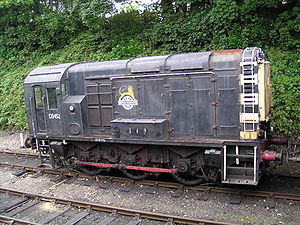 |
| DEJ7 | D3/5 British Rail Class D3/5 British Rail Class D3/5 was a shunting locomotive built by British Rail at their Darlington Works in England. It was a diesel powered locomotive in the pre-TOPS period and the class was numbered 13152–13166 .... |
3/1D | 13152–13166 | D3152–D3166 | 1955 | 15 | 1967 | ||
| D3/6 British Rail Class D3/6 Class D3/6 were diesel shunters built in 1935 by English Electric for the London, Midland and Scottish Railway. They were the first of a new design of diesel shunters based on the English Electric 6K of diesel engine.-Numbering:... |
12000–12002 | 1935 | 11 | 1956–62 | |||||
| D3/7 British Rail Class D3/7 British Railways Class D3/7 were diesel shunters built from May 1939 through to July 1942 by the London, Midland and Scottish Railway at their Derby Works. They were the first of a new design of diesel shunters based on the English Electric 6K diesel engine of .-Numbering:These were given LMS... |
3/8 | 12003–12032 | 1939–42 | 30 | 1966–67 | ||||
| Class 11 British Rail Class 11 The British Rail Class 11 was applied to a batch of diesel shunting locomotives built from April 1945 to December 1952, based on a similar earlier batch built by the London, Midland and Scottish Railway between 1939 and 1942.-Numbering:... |
DEJ3 | D3/8 British Rail Class 11 The British Rail Class 11 was applied to a batch of diesel shunting locomotives built from April 1945 to December 1952, based on a similar earlier batch built by the London, Midland and Scottish Railway between 1939 and 1942.-Numbering:... |
3/8A | 12033–12138 | 1945–52 | 136 | 1967–72 | ||
| DEJ1 | D3/9 British Rail Class D3/9 British Rail Class D3/9 was a class of four locomotives built by the London and North Eastern Railway at their Doncaster Works in England. It was a diesel powered locomotive in the pre-TOPS period.-References:... |
3/10 | 15000–15003 | 1944 | 4 | 1967 | |||
| D3/10 British Rail Class D3/10 British Rail Class D3/10 was a locomotive commissioned by the Great Western Railway in England, and later taken over by British Railways. It was a diesel powered locomotive in the pre-TOPS period.-Sources:... |
3/11A | 15100 | 1936 | 1 | 1965 | ||||
| D3/11 British Rail Class D3/11 British Rail Class D3/11 was a locomotive commissioned by the Great Western Railway, but delivered to its successor British Rail in England. It was a diesel powered locomotive in the pre-TOPS period.-Statistics:*Great Western number range: 501... |
3/11 | 15101–15106 | 1948 | 6 | 1967 | ||||
| D3/12 British Rail Class D3/12 British Rail class D3/12 was a class of three experimental diesel-electric shunting locomotives designed by Richard Maunsell of the Southern Railway in 1937... |
3/9A | 15201–15203 | 1937 | 3 | 1964 | ||||
| Class 12 British Rail Class 12 The British Rail Class 12 is a diesel locomotive built primarily for shunting duties around London.-History:This was the second batch of Southern Railway shunters based on the English Electric 6KT 350 hp diesel engine. The first experimental batch were designed by Richard Maunsell of the SR in... |
D3/13 British Rail Class 12 The British Rail Class 12 is a diesel locomotive built primarily for shunting duties around London.-History:This was the second batch of Southern Railway shunters based on the English Electric 6KT 350 hp diesel engine. The first experimental batch were designed by Richard Maunsell of the SR in... |
3/9 | 15211–15236 | 1949–52 | 24 | 1968–71 (still in industrial use) | |||
| DEJ2 | D3/14 British Rail Class D3/14 British Rail Class D3/14 was a diesel-electric locomotive built by the London and North Eastern Railway at its Doncaster Works. It had a Petter engine, and Brush Traction electricals... |
3/2 | 15004 | 1949 | 1 | 1962 | |||
| Class 13 British Rail Class 13 The British Rail Class 13 were created in 1965 because of a necessity to provide more powerful shunters for the Tinsley Marshalling Yard. This was achieved by permanently coupling together two Class 08 shunters as a 'master and slave' units, the latter with its cab removed... |
7/1 | D4500–D4502 | 1965 | 3 | 1983–1985 |  |
|||
| Class 14 British Rail Class 14 The British Rail Class 14 is a type of small diesel-hydraulic locomotive built in the mid-1960s. Twenty-six of these 0-6-0 locomotives were ordered in January 1963, to be built at British Railways Swindon Works. The anticipated work for this class was yard shunting, trip work and short distance... (Teddy Bear) |
6/1 | D9500–D9555 | 1964 | 56 | 1968–69 | 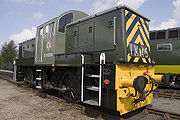 |
|||
- Relation between TOPS, 1948, 1955 and 1962 classes, and 1948, 1957 and TOPS numbers:
Type 1 locomotives: 800 - 1000hp
| CLASS | 1957 numbers | Introduced | Quantity | Withdrawn | Image | ||
|---|---|---|---|---|---|---|---|
| TOPS | 1955 | 1962 | |||||
| 10800 British Rail 10800 British Railways 10800 was a diesel locomotive built by the North British Locomotive Company for British Railways in 1950. It had been ordered by the London, Midland and Scottish Railway in 1946 but did not appear until after the 1948 nationalisation of the railways.Design was by George Ivatt and... |
1950 | 1 | 1972 | ||||
| Class 15 British Rail Class 15 The British Rail Class 15 diesel locomotives, also known as the BTH Type 1, were designed by British Thomson-Houston, and built by the Yorkshire Engine Company and the Clayton Equipment Company, between 1957 and 1961.- Design history :... |
D8/1 | 8/5 | D8200-D8243 | 1957-61 | 44 | 1969-71 |
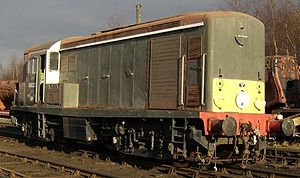 |
| Class 16 British Rail Class 16 The North British Type 1 was a type of diesel locomotive ordered under British Railways' 1955 Modernisation Plan. Like other Type 1 designs, they were relatively small locomotives intended primarily for local freight traffic.... |
D8/2 | 8/4 | D8400-D8409 | 1958 | 10 | from 1968 | |
| Class 17 British Rail Class 17 The British Rail Class 17 was a class of 117 Bo-Bo diesel-electric locomotives built 1962–1965 by Clayton Equipment Company and their sub-contractor Beyer, Peacock & Co., for British Railways .... |
N/A | 9/18 | D8500-D8587 | 1962-65 | 117 | by 1971 | 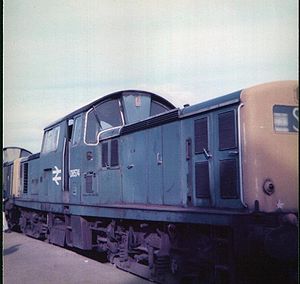 |
| 9/19 | D8588-D8616 | ||||||
| Class 18 | 1985 (Proposed) |
Never Built | |||||
| Class 20 British Rail Class 20 The British Rail Class 20, otherwise known as an English Electric Type 1, is a class of diesel-electric locomotive. In total, 228 locomotives in the class were built by English Electric between 1957 and 1968, the large number being in part because of the failure of other early designs in the same... |
D10/3 | 10/3 | D8000-199, D8300-27 |
1957-67 | 228 | still in use |  |
- Relation between TOPS, 1948, 1955 and 1962 classes, and 1948, 1957 and TOPS numbers (unless otherwsie given):
Type 2 locomotives: 1001 - 1499hp
Locomotive class are listed by TOPS class. Locomotives for TOPS classes 24 and 26 have their original sub-classes shown, as each wholly comprised locomotives from a distinct 1962 class.| CLASS | 1957 numbers | Introduced | Quantity | Withdrawn | Image | |||
|---|---|---|---|---|---|---|---|---|
| TOPS | 1955 | 1962 | ||||||
| Class 21 (NBLC) British Rail Class 21 The British Rail Class 21 was a type of Type 2 diesel-electric locomotive built by the North British Locomotive Company in Glasgow for British Railways in 1958-1960.... |
D10/1 | 10/4 | D6100-D6157 | 1959 | 58 | 1967 | ||
| D11/2 | 11/4 | |||||||
| Class 21 (Vossloh) | N/A | N/A | N/A | 2004-05 | 4 | still in use |  |
|
| Class 22 British Rail Class 22 The British Rail Class 22 or "Baby Warship" was a class of diesel-hydraulic locomotives designed for the Western Region of British Railways and built by the North British Locomotive Company. They were very similar in appearance to the Class 21 diesel-electrics... |
D10/2A | 10/4A | D6300-D6305 | 1959 | 58 | 1967-72 |  |
|
| D11/5 | 11/4A | D6306-D6357 | ||||||
| Class 23 British Rail Class 23 The British Rail Class 23 were a class of ten Bo-Bo diesel-electric locomotives built by the English Electric Company in 1959. The power unit used was a Napier Deltic T9-29 9-cylinder engine of driving an EE generator, which powered the four traction motors... (Baby Deltic) |
D11/1 | 11/3 | D5900-D5909 | 1959 | 10 | 1968-71 | 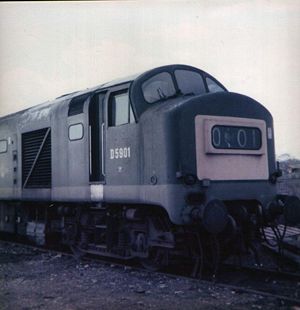 |
|
| Class 24 British Rail Class 24 The British Rail Class 24 diesel locomotives, also known as the Sulzer Type 2, were built from 1958 to 1961. One hundred and fifty-one of these locomotives were built at Derby, Crewe and Darlington, the first twenty of them as part of the British Rail 1955 Modernisation Plan. This class was used as... |
24/0 | 11/1 | D5000-D5049 | 1958-61 | 50 | by 1980 |  |
|
| 24/1 | D11/3 | 11/1A | D5050-5150 | 101 | ||||
| Class 25 British Rail Class 25 The British Rail Class 25 diesel locomotives were also known as Sulzer Type 2 and nicknamed Rats, as it was alleged they could be seen everywhere in Britain, and hence were "as common as rats"... |
D12/1 | 12/1 | D5151–D5299, D7500–D7677 |
1961-67 | 323 | 1987 | 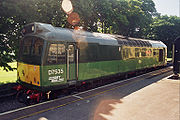 |
|
| Class 26 British Rail Class 26 The British Rail Class 26 diesel locomotives, also known as the BRCW Type 2, were built by the Birmingham Railway Carriage & Wagon Company at Smethwick in 1958-59. Forty seven examples were built, and the last were withdrawn from service in 1993... |
26/0 | D11/4 | 11/6 | D5300-D5319 | 1958 | 20 | 1975-93 | 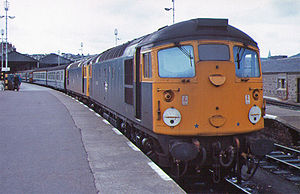 |
| 26/1 | none | 11/6A | D5320-D5346 | 1958 | 27 | |||
| Class 27 British Rail Class 27 British Rail's Class 27 comprised 69 diesel locomotives built by the Birmingham Railway Carriage and Wagon Company during 1961 and 1962. They were a development of the earlier Class 26; both were originally classified as the BRCW Type 2.- Usage :... |
D12/3 | 12/6 | D5347-D5415 | 1961-62 | 69 | 1987 | 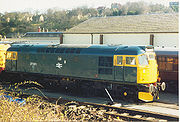 |
|
| Class 28 British Rail Class 28 The British Rail Class 28 diesel locomotives, or 'Metrovicks' as they were popularly known, were built as part of the British Railways 1955 Modernisation Plan. The locomotives had a Co-Bo wheel arrangement – unique in British Railways practice though not uncommon in other countries, notably Japan... |
D12/1 | 12/5 | D5700-D5719 | 1958-59-59 | 20 | 1968-71 | ||
| Class 29 British Rail Class 29 The British Rail Class 29 were a class of 20 diesel-electric Bo'Bo' locomotives produced by the re-engining of the British Rail Class 21 units. The units were designed for both passenger and freight trains... |
N/A | N/A | N/A | 1965-1967 | 20 | 1971 | ||
| Class 30 & 31 British Rail Class 31 The British Rail Class 31 diesel locomotives, also known as the Brush Type 2 and originally as Class 30, were built by Brush Traction from 1957-62.- Description :... |
D13/1, D14/2 | 14/2 | D5500-D5862 | 1957-62 | 263 plus 81 conversions |
1976 - date still in use |
 |
|
- Relation between TOPS, 1948, 1955 and 1962 classes, and 1948, 1957 and TOPS numbers (unless otherwise given):
Type 3 locomotives: 1500–1999hp
| CLASS | Pre-TOPS numbers |
Introduced | Quantity | Withdrawn | Image | ||
|---|---|---|---|---|---|---|---|
| TOPS | 1955 | 1962 | |||||
| Class 33 British Rail Class 33 The British Rail Class 33 also known as the BRCW Type 3 or Crompton is a class of Bo-Bo diesel-electric locomotives ordered in 1957 and built for the Southern Region of British Railways between 1960 and 1962.... |
D15/1 | 15/6 | D6500—D6585 | 1960-62 | 98 | still in use |  |
| D15/2 | 15/6A | D6586-D6597 | |||||
| Class 35 British Rail Class 35 The British Rail Class 35 is a class of mixed-traffic B-B diesel locomotive with hydraulic transmission. Because of their Mekydro-design hydraulic transmission units, the locomotives became known as the Hymeks.... (Hymek) |
D17/2 | 17/7 | D7000–D7100 | 1961-64 | 101 | 1971-1975 | 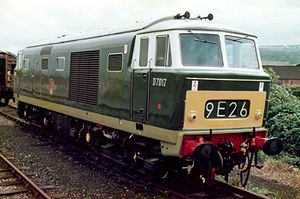 |
| Class 37 British Rail Class 37 The British Rail Class 37 is a diesel-electric locomotive. Also known as the English Electric Type 3, the Class was ordered as part of the British Rail modernisation plan.... |
D17/1 | 17/3 | D6600-D6608 D6700-D6999 |
1960 - 65 | 309 | still in use | 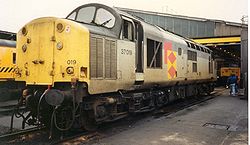 |
| Class 38 | 1980s (Proposed) |
Never Built | |||||
| Class D16/1 British Rail Class D16/1 British Railways Class D16/1 or 10000 and 10001 were the first mainline diesel locomotives in Great Britain. They were built by the London, Midland and Scottish Railway at its Derby Works, using the EE16SVT 1600 hp diesel engine with electric transmission, in association with English Electric and... |
16/8 | 10000-10001 | 1947-48 | 2 | 1962-66 | 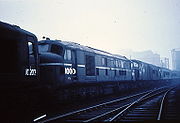 |
|
| Class D16/2 British Rail Class D16/2 British Railways Class D16/2 was a class of prototype diesel locomotive built by BR at Ashford Works and introduced in 1950-1951, with a third example being introduced in 1954. They had been designed by Oliver Bulleid for the Southern Railway before the 1948 nationalisation but did not appear until... |
16/9 | 10201-10203 | 1951-1954 | 3 | 1968 | 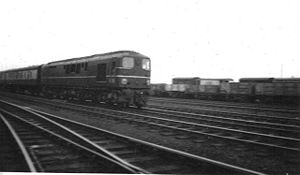 |
- Relation between TOPS, 1955 and 1962 classes, and pre-TOPS and TOPS numbers (unless otherwise given):
Type 4 locomotives: 2000–2999hp
| CLASS | 1957 numbers | Built | Quantity | Withdrawn | Image | ||
|---|---|---|---|---|---|---|---|
| TOPS | 1955 | 1962 | |||||
| 10100 British Rail 10100 British Railways 10100 was an unusual experimental diesel locomotive known informally as The Fell Diesel Locomotive . It was the joint production of Davey Paxman & Co, Shell Refining & Marketing Co and Lt-Col L.F.R. Fell, built for them by the London, Midland and Scottish Railway at Derby. Sir... |
1950 | 1 | 1958 | ||||
| Class 40 British Rail Class 40 The British Rail Class 40 is a type of British railway diesel locomotive. Built by English Electric between 1958 and 1962, and eventually numbering 200, they were for a time the pride of the British Rail early diesel fleet... |
D20/1 | 20/3 | D200-D399 | 1958-62 | 200 | by 1985 |  |
| D20/2 | 20/4 | D600-D604 | 1958-59 | 5 | 1967 | ||
| Class 41 British Rail Class 41 (HST) The British Rail Class 41 was the original classification for the power cars of the prototype High Speed Train. However, the train was later re-classified as a diesel-electric multiple unit, and the whole set became Class 252. They were of Bo-Bo wheel arrangement.Two power cars were built, 41001... (Prototype HST) |
N/A | 1972 | 2 | 1982 | 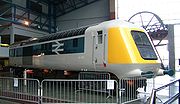 |
||
| Class 41 | N/A | 1990s (Proposed) |
Never Built | ||||
| Class 42 British Rail Class 42 British Railways' Type 4 Warship class diesel-hydraulic locomotives were introduced in 1958. It was apparent at that time that the largest centre of expertise on diesel-hydraulic locomotives was in Germany... |
D22/1 | 22/1 | D800-D832,D866-D870 | 1958-61 | 38 | 1968-72 | .jpg) |
| Class 43 British Rail Class 43 (Warship Class) The British Rail Class 43 diesel-hydraulic locomotives were built by the North British Locomotive Company from 1960–1962.-Classification:... |
D22/2 | 22/2 | D833-D865 | 1960-62 | 33 | ? | 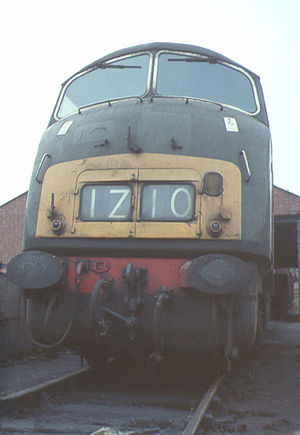 |
| Class 43 (HST) British Rail Class 43 (HST) The British Rail Class 43 is the TOPS classification used for the InterCity 125 High Speed Train power cars, built by BREL from 1975 to 1982.... |
N/A | 1976-82 | 197 | Still in use |  |
||
| Class 44 British Rail Class 44 The British Rail Class 44 or Sulzer Type 4 diesel locomotives were built by British Railways' Derby Works between 1959 to 1960. They were named after British mountains, and consequently nicknamed Peaks.-Description:... (Peak) |
D23/1 | 23/1 | D1-D10 | 1959-60 | 10 | 1976-81 |  |
| Class 45 British Rail Class 45 The British Rail Class 45 also known as the Sulzer Type 4 diesel locomotives were built by British Rail at their Derby and Crewe Works between 1960 and 1962... |
D25/1 | 25/1 | D11-D137 | 1960-63 | 127 | by 1989 |  |
| Class 46 British Rail Class 46 The British Rail Class 46 is a class of diesel locomotive. They were built from 1961-1963 at British Railways' Derby Works and were initially numbered D138-D193. With the arrival of TOPS they were renumbered to Class 46. Fifty-six locomotives were built... |
N/A | 25/1A | D138-D193 | 1961 | 56 | after 1983 but before 1989 |
|
| Class 47 British Rail Class 47 The British Rail Class 47, is a class of British railway diesel-electric locomotive that was developed in the 1960s by Brush Traction. A total of 512 Class 47s were built at Crewe Works and Brush's Falcon Works, Loughborough between 1962 and 1968, which made them the most numerous class of British... |
N/A | 27/2 | D1100-D1111, D1500-D1999 |
1962-68 | 512 | still in use | 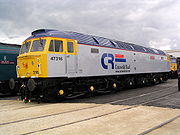 |
| Class 48 British Rail Class 48 The British Rail Class 48 was a diesel locomotive class which consisted of five examples, built at Brush Falcon Works in Loughborough and delivered between September 1965 and July 1966... |
N/A | 27/2 | D1702-D1706. | 1965-66 | 5 | 1990-91 | |
| Class 50 British Rail Class 50 The British Rail Class 50 is a diesel locomotive built from 1967-68 by English Electric at their Vulcan Foundry Works in Newton-le-Willows. Fifty of these locomotives were built to haul express passenger trains on the, then non-electrified, section of the West Coast Main Line between Crewe,... |
N/A | 27/3 | D400-D449 | 1967-68 | 50 | by 1992 |  |
| Class 52 British Rail Class 52 British Rail assigned Class 52 to the class of 74 large Type 4 diesel-hydraulic locomotives built for the Western Region of British Railways between 1961 and 1964... (Western) |
D27/1 | 27/1 | D1000-D1073 | 1961–1964 | 74 | by 1977 | |
| Class 53 British Rail Class 53 British Rail assigned Class 53 to the single Brush Traction-built prototype locomotive Falcon. While not in any sense a failure, the design was the victim of advances in locomotive technology and was never duplicated.- History :The Falcon project began in 1959 to design a new, lightweight... Falcon |
? | ? | D0280, later D1200 | 1961 | 1 | 1976 | 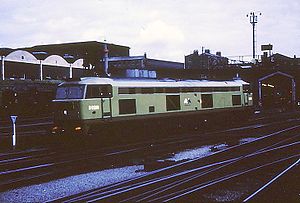 |
| Class 57 British Rail Class 57 The Class 57 diesel locomotives were introduced by Brush Traction between 1997-2004. They are rebuilds, with reconditioned EMD engines, of former Class 47 locomotives, originally introduced in 1964-5.- Description :... |
N/A | 1962-1968 Rebuilt 1997 - 2004 | 33 | still in use |  |
||
Type 5 locomotives: over 3000hp
| TOPS class | Built | Quantity | Withdrawn | Image |
|---|---|---|---|---|
| Class 51 | 1960s (Proposed) |
Never Built | ||
| Class 55 British Rail Class 55 The British Rail Class 55 is a class of diesel locomotive built in 1961 and 1962 by English Electric. They were designed for the high-speed express passenger services on the East Coast Main Line between and Edinburgh. They gained the name "Deltic" from the prototype locomotive, DP1 Deltic, which... (Deltic) |
1961-62-62 | 22 | 1982 | |
| Class 56 British Rail Class 56 The British Rail Class 56 is a type of diesel locomotive designed for heavy freight work. It is a Type 5 locomotive, with a Ruston-Paxman power unit developing 3,250 bhp , and has a Co-Co wheel arrangement... |
1976-84 |
135 | still in use |  |
| Class 58 British Rail Class 58 The British Rail Class 58 is a class of Co-Co diesel locomotive designed for heavy freight. Introduced in 1983, they followed American practice of modularisation. From new they were painted in grey Railfreight Sector livery, instead of BR blue... |
1983-87 | 50 | still in use (In mainland Europe) |
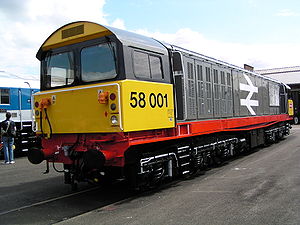 |
| Class 59 British Rail Class 59 The Class 59 Co-Co diesel locomotives were built and introduced between 1985 and 1995 by Electro-Motive Division of General Motors for private British companies, initially Foster Yeoman... |
1985-95 | 15 | still in use |  |
| Class 60 British Rail Class 60 The British Rail Class 60 is a class of Co-Co heavy freight diesel-electric locomotives built by Brush Traction. They are nicknamed Tugs by Rail Enthusiasts.-History:... |
1989-93 | 100 | still in use |  |
| Class 62 | 1990s (Proposed) |
Never Built | ||
| Class 65 | Never Built | |||
| Class 66 British Rail Class 66 The Class 66 is a six axle diesel electric freight locomotive developed in part from the British Rail Class 59, for use on the railways of the UK. Since its introduction the class has been successful and has been sold to British and other European railway companies... |
1998-2008 | 446 | still in use |  |
| Class 67 British Rail Class 67 The Class 67 locomotives are a class of Bo'Bo' diesel electric mainline locomotives which were built for the English, Welsh and Scottish Railway between 1999 to 2000 by Alstom at Meinfesa in Valencia, Spain with drive components from General Motors Diesel.Rail enthusiasts have nicknamed the class... |
1999-2000 | 30 | still in use |  |
| Class 70 | 2009- | 30 (planned) | In use still in production |
Electric locomotives


DC electric locomotives
| TOPS class | pre-TOPS class | Built | Quantity | Withdrawn | Image |
|---|---|---|---|---|---|
| Class 70 British Rail Class 70 The British Rail Class 70 was a class of three 3rd rail Co-Co electric locomotives. The initial two were built by the Southern Railway at Ashford Works in 1941 and 1945 and were numbered CC1 and CC2. Electrical equipment was designed by Alfred Raworth and the body by Oliver Bulleid. CC2 was... |
1941-48 | 3 | 1968-69 | ||
| Class 71 British Rail Class 71 The British Rail Class 71 was an electric locomotive used on the Southern Region of British Railways, unlike most other Southern Region electric locomotives they could not operate away from the electrified system.- History :As part of the BTC Modernisation Plan of 1955, twenty-four electric... |
HA | 1958-60 | 24 | 1977 |  |
| Class 73 British Rail Class 73 The British Rail Class 73 is a United Kingdom model of electro-diesel locomotive. The type is unusual in that it can operate from a 750 V DC third-rail or an on-board diesel engine to allow it to operate on non-electrified routes... (electric and Diesel power) |
JA or JB | 1962 1965-67 |
82 | still in use |  |
| Class 74 British Rail Class 74 British Rail Class 74 was an electro-diesel locomotive that operated on the Southern Region of British Railways, rebuilt from redundant Class 71 locomotives in the late 1960s... (electric and Diesel power) |
HB | 1958–1960 Rebuilt 1967–1968 |
10 | 1976 | 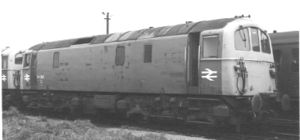 |
| Class 75 | 1960s (Proposed) |
Never Built | |||
| Class 76 British Rail Class 76 The British Rail Class 76, also known as Class EM1 , is a class of 1.5 kV DC, Bo-Bo electric locomotive designed for use on the now-closed Woodhead Line in Northern England.-Tommy — the prototype:... |
EM1 | 1952-53 | 56 | 1981 | 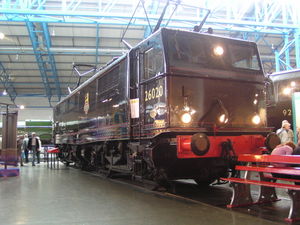 |
| Class 77 British Rail Class 77 The British Rail Class 77, also known as Class EM2, is a class of 1.5 kV DC, Co-Co electric locomotive. They were built by Metropolitan-Vickers in 1953–1954 for use over the Woodhead Line between Manchester and Sheffield.-Description:... |
EM2 | 1953-55 | 7 | 1969 | 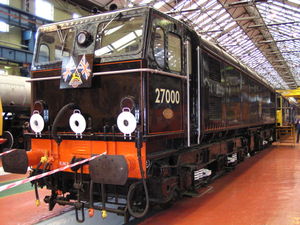 |
| Class EB1 British Rail Class EB1 The British Rail Class EB1 was an electrically powered locomotive used by British Rail in England. It was used during the pre-TOPS period... (26502-26511) |
? | ? | ? | ||
| Class EE1 British Rail Class EE1 British Rail Class EE1 was an electric locomotive commissioned by the North Eastern Railway in 1922. Ownership passed to the London and North Eastern Railway in 1923 and to British Railways in 1948.... (26600) |
? | ? | ? | ||
| Class ES1 British Rail Class ES1 British Rail Class ES1 was a class of two electric locomotives commissioned by the North Eastern Railway in 1902. They were of steeplecab design.... (26500-26501) |
1905 | 2 | 1964 |  |
AC electric locomotives
| TOPS class | pre-TOPS class | Built | Quantity | Withdrawn | Image |
|---|---|---|---|---|---|
| Class 80 British Rail Class 80 Class 80 was the TOPS classification allocated by British Rail to the prototype 25 kV AC electric locomotive. This locomotive was built by Metropolitan-Vickers, initially as a prototype Gas turbine-electric locomotive, numbered 18100... |
1958 | 1 | 1961 | ||
| Class 81 British Rail Class 81 The British Rail Class 81 is an AC electric locomotive that formerly operated on the West Coast Main Line of the London Midland Region of British Rail... |
AL1 | 1959–1964 | 25 | 1991 |  |
| Class 82 British Rail Class 82 The British Rail Class 82 electric locomotives were built by Beyer, Peacock and Company between 1960 and 1962 as part of the West Coast Main Line electrification.- History :... |
AL2 | 1960-62 | 12 | 1987 | 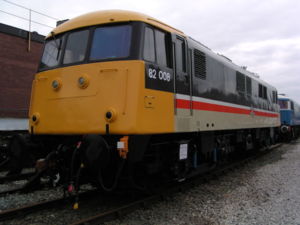 |
| Class 83 British Rail Class 83 The British Rail Class 83 electric locomotives were built by English Electric at Vulcan Foundry, Newton-le-Willows as part of the West Coast Main Line electrification.- History :... |
AL3 | 1960-62 | 15 | 1989 | 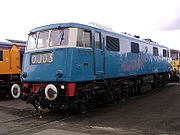 |
| Class 84 British Rail Class 84 The British Rail Class 84 was a 25 kV AC electric locomotive that operated on the West Coast Main Line of the London Midland Region.- History :... |
AL4 | 1960-61 | 10 | 1979-80 |  |
| Class 85 British Rail Class 85 The British Rail Class 85 is an electric locomotive built during the early 1960s, as part of BR's policy to develop a standard electric locomotive. Five prototype classes were built and evaluated, which eventually led to the development of the Class 86 locomotive... |
AL5 | 1961-64 | 40 | 1991 | |
| Class 86 British Rail Class 86 The British Rail Class 86 was the standard electric locomotive built during the 1960s, developed as a result of testing with the earlier Classes 81, 82, 83, 84 and 85. One hundred of these locomotives were built from 1965-1966 by either English Electric at Vulcan Foundry, Newton-le-Willows, or... |
AL6 | 1965-66 | 100 | 2002-date still in use | 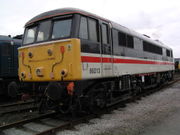 |
| Class 87 British Rail Class 87 The British Rail Class 87 is a type of electric locomotive built from 1973-75 by British Rail Engineering Limited . 36 of these locomotives were built to work passenger services over the West Coast Main Line . They were the flagships of British Rail's electric locomotive fleet until the late 1980s,... |
1973-75 | 36 | 2003-date still in use | 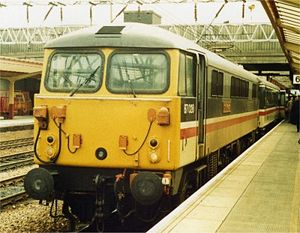 |
|
| Class 88 | 1983-87 (planned) |
Never Constructed | |||
| Class 89 British Rail Class 89 The Class 89 is a prototype design for an electric locomotive. Only one unit was built, no. 89001, which was officially named Avocet by the then Prime Minister Margaret Thatcher on 16 January 1989 at Sandy, Bedfordshire - the home of the Royal Society for the Protection of Birds... |
1986 | 1 | 2001 |  |
|
| Class 90 British Rail Class 90 The British Rail Class 90 electric locomotives were built by BREL at Crewe from 1987-1990. Each locomotive weighs 84.5 tonnes and has a top speed of . They operate from 25 kV AC overhead wires and produce... |
1987-90 | 50 | still in use | 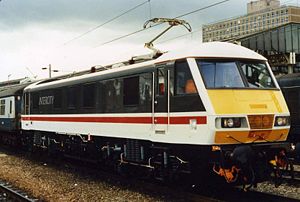 |
|
| Class 91 British Rail Class 91 The British Rail Class 91 is a class of , electric locomotives ordered as a component of the East Coast Main Line modernisation and electrification programme of the late 1980s. The Class 91s were given the auxiliary name of InterCity 225 to indicate their envisaged top speed of... |
1988-91 | 31 | still in use | 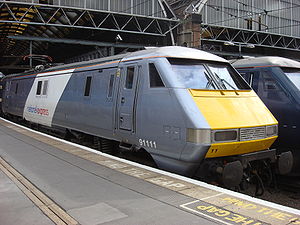 |
|
| Class 92 British Rail Class 92 The British Rail Class 92 is a dual-voltage electric locomotive which can run on 25 kV AC from overhead wires or 750 V DC from a third rail. It was designed specifically to operate services through the Channel Tunnel between Britain and France... |
1993-96 | 46 | still in use |  |
|
| Class 93 British Rail Class 93 British Rail Class 93 is the traction classification assigned to the electric locomotives that were to enter service as part of British Rail's InterCity 250 project on the West Coast Main Line .... |
1992-95 (planned) |
30 (planned) |
Never Constructed |  |
Miscellaneous locomotives
| Type | Class / number(s) | Information | Image |
|---|---|---|---|
| Channel Tunnel | Class 22 SNCF Class BB 22200 The BB 22200 is a class of electric locomotives in service with the French railways SNCF, built by Alsthom between 1976-1986. They are a dual voltage version of the BB 7200 and BB 15000 classesThe designation "22000" is in fact the sum of 7200 and 15000.From 1994 nine BB 22200 units were used for... |
SNCF SNCF The SNCF , is France's national state-owned railway company. SNCF operates the country's national rail services, including the TGV, France's high-speed rail network... Class BB 22200 class dual voltage electric locomotives used for freight duties through the Channel Tunnel Channel Tunnel The Channel Tunnel is a undersea rail tunnel linking Folkestone, Kent in the United Kingdom with Coquelles, Pas-de-Calais near Calais in northern France beneath the English Channel at the Strait of Dover. At its lowest point, it is deep... by Railfreight Distribution Railfreight Distribution Railfreight Distribution was a subsector of British Rail created by the division in 1987 of British Rail's previous Railfreight sector. It was responsible for non-trainload freight operations, as well as Freightliner and Intermodal services. In its early years the division was occasionally... during 1994-95, prior to the availability of the dedicated Class 92 British Rail Class 92 The British Rail Class 92 is a dual-voltage electric locomotive which can run on 25 kV AC from overhead wires or 750 V DC from a third rail. It was designed specifically to operate services through the Channel Tunnel between Britain and France... locomotives. These locomotives were allocated the TOPS classification Class 22 for their use on British railways |
|
| Departmental | Class 97 British Rail Class 97 British Rail reserved the TOPS Class 97 designation for departmental locomotives, which were used for special or engineering duties. They were therefore of several different classes, lumped together for numbering purposes. Some locomotives were converted from redundant engines, whilst others were... |
General departmental locomotives, used for special or engineering duties. Were therefore of many different classes, lumped together for numbering purposes. Forty-seven locomotives allocated Class 97 numbers, including five in subclass 97/6. | |
| Class 97/6 British Rail Class 97/6 The British Rail Class 97/6 0-6-0 diesel shunting locomotives were purpose-built for departmental duties by Ruston & Hornsby at Lincoln in 1953 or 1959... |
Five diesel shunting locomotives purpose-built for departmental duties in 1953 (number 97650) and 1959 (numbers 97651-654). Withdrawn 1987-2005. | 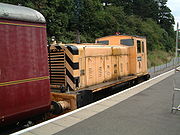 |
|
| Various Pre-TOPS Departmental Locomotives British Rail departmental locomotives Before the introduction of the Total Operations Processing System, Class 97 was issued to self-propelled locomotives in departmental use, British Rail had such locomotives numbered in a variety of series, together with locomotives that were no longer self-propelled... |
|||
| Steam | Class 98 British Rail Class 98 TOPS Class 98 has been used to cover all steam locomotives used on the mainline in Britain, but also has a particular usage for the three Vale of Rheidol Railway-design 2-6-2T locomotives that remained in the ownership of British Rail after the end of mainline steam traction in August 1968... |
Used to cover all steam locomotives used on the mainline in Britain. Had particular usage for the three Vale of Rheidol Railway steam locomotives that remained in BR's ownership after the end of mainline steam traction in August 1968, and numbered 98007-98009. Also used for privately-owned steam locomotives registered to run on the mainline since 1971, with numbers allocated in the following way:
|
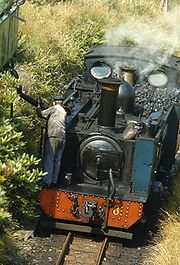 |
| Petrol | 15097-15099 | Petrol powered locomotives built by Simplex Motor Rail Motor Rail was a British locomotive-building company, based in Bedford. Formed in 1911 as The Motor Rail & Tramcar Co Ltd, they built petrol and diesel engined locomotives, mainly narrow gauge. During World War I over 900 locos were supplied for use on temporary military supply railways... , introduced 1919-1925 by the LNER London and North Eastern Railway The London and North Eastern Railway was the second-largest of the "Big Four" railway companies created by the Railways Act 1921 in Britain... , and subsequently inherited by BR |
|
| Gas turbine | 18000 British Rail 18000 British Rail 18000 was a prototype mainline gas turbine-electric locomotive built for British Railways in 1949 by Brown, Boveri & Cie. It had, however, been ordered by the Great Western Railway in 1946, but construction was delayed due to World War II... |
Prototype mainline gas turbine locomotive built for BR in 1949 by Brown Boveri. Had been ordered by GWR Great Western Railway The Great Western Railway was a British railway company that linked London with the south-west and west of England and most of Wales. It was founded in 1833, received its enabling Act of Parliament in 1835 and ran its first trains in 1838... in 1940, but construction was delayed due to World War II World War II World War II, or the Second World War , was a global conflict lasting from 1939 to 1945, involving most of the world's nations—including all of the great powers—eventually forming two opposing military alliances: the Allies and the Axis... . |
 |
| 18100 British Rail 18100 British Rail 18100 was a prototype main line gas turbine-electric locomotive built for British Railways in 1951 by Metropolitan-Vickers, Manchester. It had, however, been ordered by the Great Western Railway in the 1940s, but construction was delayed due to World War II... |
Prototype mainline gas turbine locomotive built for BR in 1951 by Metropolitan-Vickers Metropolitan-Vickers Metropolitan-Vickers, Metrovick, or Metrovicks, was a British heavy electrical engineering company of the early-to-mid 20th century formerly known as British Westinghouse. Highly diversified, they were particularly well known for their industrial electrical equipment such as generators, steam... . Had been ordered by the GWR in the 1940s, but construction was delayed due to World War II. |
||
Class 99
When British Rail implemented the TOPS system for managing their operating stock, ships capable of carrying rail vehicles were incorporated into the system as Class 99British Rail Class 99
The British Rail Class 99 was a fleet of 14 ferries, mostly owned by Sealink, which carried rail vehicles between Britain and mainland Europe. When British Rail implemented the TOPS system for managing their operating stock, these ships were incorporated into the system in order to circumvent some...
. In order to circumvent restrictions of the application software, these ships were entered on TOPS as locomotives, 'hauling' the trains which they carried on board.
Builders' demonstrators
These were locomotives built and owned by private firms, but used by British RailBritish Rail
British Railways , which from 1965 traded as British Rail, was the operator of most of the rail transport in Great Britain between 1948 and 1997. It was formed from the nationalisation of the "Big Four" British railway companies and lasted until the gradual privatisation of British Rail, in stages...
to test them.
| Locomotive | Builder | Year | Fate | Image |
|---|---|---|---|---|
| D0226 & D0227 | English Electric English Electric English Electric was a British industrial manufacturer. Founded in 1918, it initially specialised in industrial electric motors and transformers... |
1956 | D0226 preserved D0227 scrapped |
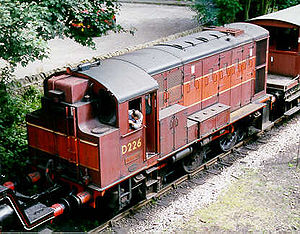 |
| D0260 Lion British Rail D0260 D0260, named Lion, was a prototype Type 4 mainline diesel locomotive built in 1962 by the Birmingham Railway Carriage and Wagon Company, in association with Sulzer and Associated Electrical Industries, at their Smethwick works in Birmingham to demonstrate their wares to British Railways... |
BRCWC Birmingham Railway Carriage and Wagon Company The Birmingham Railway Carriage and Wagon Company was a railway locomotive and carriage builder, founded in Birmingham, England and, for most of its existence, located at nearby Smethwick, with the factory was divided by the boundary between the two places... |
1962 | Scrapped in 1963 | |
| D0280 Falcon British Rail Class 53 British Rail assigned Class 53 to the single Brush Traction-built prototype locomotive Falcon. While not in any sense a failure, the design was the victim of advances in locomotive technology and was never duplicated.- History :The Falcon project began in 1959 to design a new, lightweight... See Class 53, above |
Brush Traction Brush Traction This article is about a British rail-locomotive maker. For the Detroit auto-maker, see Brush Motor Car CompanyBrush Traction is a manufacturer and maintainer of railway locomotives, part of the FKI group , based at Loughborough in Leicestershire, England situated alongside the Midland Main Line.-... |
1961 | Scrapped 1976 |  |
| D9998 British Rail Class D2/11 In 1958 Brush Traction Ltd and Beyer Peacock co-operated to produce five prototype diesel-electric shunting locomotives of 0-4-0 wheel arrangement. They were intended to demonstrate a new generation of diesel shunters for industrial and mainline use. Two were loaned to British Railways for trials,... See Class D2/11, above |
Brush Traction | 1958 | ? | |
| DHP1 British Rail DHP1 DHP1, meaning Diesel Hydraulic Prototype number 1, was a prototype Type 3 mainline diesel locomotive built in 1965 by Clayton to demonstrate their wares to British Railways. It was designed for mixed traffic work, being equipped with steam heating facilities for working passenger trains... |
Clayton | 1965 | ? | |
| DP1 Deltic British Rail DP1 DP1, known as Deltic from the name painted on the sides, is a prototype demonstrator locomotive employing a Deltic engine, built by English Electric in 1955... |
English Electric | 1955 | Withdrawn 1961, preserved |
 |
| DP2 British Rail DP2 DP2, meaning Diesel Prototype number 2, was a prototype Type 4 mainline diesel locomotive built in 1962 by English Electric at their Vulcan Foundry in Newton-le-Willows to demonstrate its wares to British Railways... |
English Electric | 1962 | Scrapped 1967 | 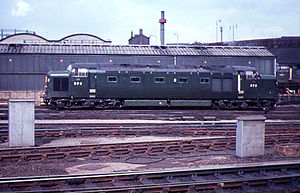 |
| GT3 British Rail GT3 -External links:* http://www.therailwaycentre.com/Pages%20Loco/Recognition%20loco/Illus_GT3.html* http://www.enuii.com/vulcan_foundry/oddities/gt3.htm* http://www.enuii.com/vulcan_foundry/magazine/Vol5_no8_1961/page_37_s.jpg... (Gas turbine) |
English Electric | 1961 | Scrapped 1966 | |
| HS4000 Kestrel British Rail HS4000 HS4000, named Kestrel, was a prototype high-powered mainline diesel locomotive built in 1967 by Brush Traction, Loughborough as a technology demonstrator for potential future British Rail and export orders The locomotive number is a combination of the initials of the owner of Brush Hawker Siddeley... |
Brush Traction | 1968 | Scrapped 1989 | 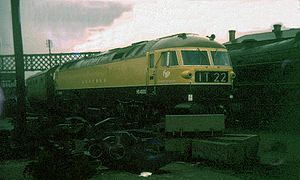 |
| Janus & Taurus British Rail Janus Janus and Taurus were two models of diesel shunting locomotives by the Yorkshire Engine Company; one prototype of each being loaned to British Railways for demonstrations. However, BR did not buy any production versions after testing... (Group of locomotives) |
Yorkshire Engine Company Yorkshire Engine Company The Yorkshire Engine Company was a small independent locomotive manufacturer in Sheffield, England. The Company was formed in 1865 and continued to produce locomotives and carry out general engineering work until 1965... |
Varied |  |
|
Unbuilt locomotives
A number of TOPSTOPS
Total Operations Processing System, or TOPS, is a computer system for managing the locomotives and rolling stock owned by a rail system...
class numbers were allocated to proposed locomotives, both diesel and electric, which for many reasons were not proceeded with.
See also
- British Rail locomotive and multiple unit numbering and classificationBritish Rail locomotive and multiple unit numbering and classificationA number of different numbering and classification schemes were used for locomotives and multiple units operated by British Railways , and this page explains the principal systems...
- Steam locomotives of British RailwaysSteam locomotives of British RailwaysThe steam locomotives of British Railways were used by British Railways over the period 1948–1968. The vast majority of these were inherited from its four constituent companies, the "Big Four"....
- British Rail coach designationsBritish Rail coach designationsThe London, Midland and Scottish Railway and the London and North Eastern Railway both developed a system of identifying railway carriages by means of alphabetic codes...

